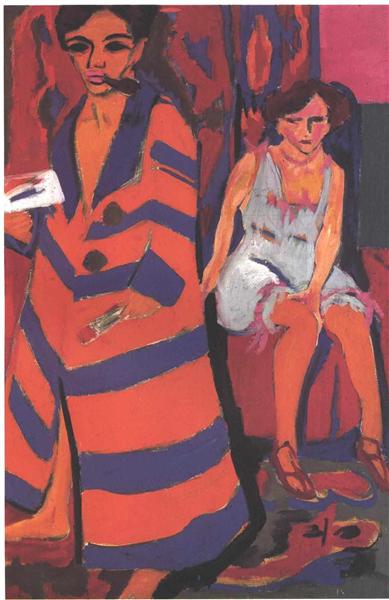Description
The work "Self -portrait with model" of Ernst Ludwig Kirchner, carried out in 1910, is registered in the context of German expressionism, a movement characterized by its emotional approach and its rejection of the realistic representation of life. This self -portrait is not only a window to the artist's psychology, but also a reflection of tensions between the individual and his environment in a time of deep social and cultural changes.
In the painting, Kirchner is presented in a frontal and dominant way, sitting at his canvas, while he is in the company of a female model that is lying to his side. This duality highlights an intimate relationship between the creator and his muse, perceiving this interaction allows to glimpse the complexity of his personal and artistic connection. The artist's position suggests an attitude of trust, almost challenge, in an environment that can be read as both private and public, given the context of a painter's work at that time.
The composition is organized around a bold use of color and shape. Kirchner uses a vibrant and contrasting palette that highlights the figures and the background. The red, green and yellow tones evoke an emotional intensity that is characteristic of their style. The modeling of both figures is angular and stylized, with marked contours that provide a feeling of dynamism and energy to the work. This stylistic choice moves away from the conventions of academicism and shows the influence of African tribal art that Kirchner admired, as well as his preferences for a more visceral and subjective representation.
The treatment of light and shadow also deserves a special mention; The lighting seems to come from a non -visible source, which adds an almost mystical aura to the scene. The figure of the model, in its relaxed posture, contrasts to some extent with the artist's intense energy. This contrast can be interpreted as a representation of the dualities present in the life of Kirchner himself, between creativity and vulnerability, between the figure of the creator and that of the object of his inspiration.
In addition to his obvious technical mastery, "Self -portrait with model" can be seen as a reflection on Kirchner's own identity as an artist and as an individual. The fact that Kirchner is represented with his model suggests an exploration of the complexities of artistic creation, where the artist is in a constant dialogue with his subject. This self -portrait is, consequently, a testimony of their internal struggles, their personal demons and the search for their own voice in a world in the process of modernization.
The work is also a powerful representation of an era marked by alienation and disenchantment. Through his expressionist technique and creative vision, Kirchner invites the viewer to cross the threshold of his inner world, inviting him to share both his fragility and his creative force. In this work, the spectator becomes a witness not only of the act of creation, but of the constant struggle that implies being at the forefront of art in a time of social seizures.
In conclusion, "Ernst Ludwig Kirchner model self -portrait is a work that articulates the notions of identity, creativity, and the role of the female figure in the artistic process. Through a striking fusion of color, form and emotion, painting not only documes a moment in the artist's life, but also resonates with the intensity of universal human feelings, establishing Kirchner as one of the great masters of expressionism.
KUADROS ©, a famous paint on your wall.
Hand-made oil painting reproductions, with the quality of professional artists and the distinctive seal of KUADROS ©.
Art reproduction service with satisfaction guarantee. If you are not completely satisfied with the replica of your painting, we refund your money 100%.

